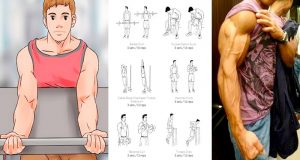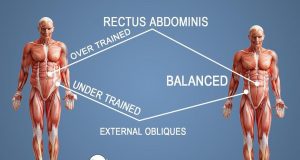The Deadlift. The ego lift of the lower body. Big numbers and big weights can go up rather easily for most athletes when practicing this lift. Like anything, with success comes haste and with haste comes the casualties of quality and diligence. For any athlete using the deadlift regularly, CrossFit, powerlifters, or traditional athletes, it is a movement that must be used carefully. This article will talk about why you don’t need to deadlift for a max, replacements for it, and specifically how this applies to CrossFit athletes.
Don’t get me wrong. As a coach and athlete I will argue that the deadlift is a very valuable strengthening tool for the posterior chain. Not many lifts use so many large muscles that allow us to lift such large amounts of weight. It isn’t that uncommon to see an athlete training with the deadlift for only a few months to get to the point where they can lift 1.5x or even 2x bodyweight and more. With more accessory training and time a 3x bodyweight deadlift is attainable for more highly skilled and better trained athletes. For this and other reasons it is a lift that needs to be closely monitored in training cycles.
The reason I am careful with the deadlift, both in my own training and in the training of athletes I work with, is that it is extremely taxing when trained to a max, both on the CNS due to the heavy amount of weight being held, and on the posterior chain. In reference to the former, if an athlete is training to a max (and to a max is referring to working to a maximum weight for a rep scheme of 3 or less) every week or more than once a week, they are most likely wearing the body down more than it is worth which greatly affects following training days. In reference to the latter, any coach or athlete who is relatively well educated in strength training will say that training lifts to a max will sometimes lead to a lifter losing perfect form. Some coaches may even argue (me being among them) that it is OK to lose form to a certain extent during a max lift because it trains the body how to get out of a not perfect lift safely and successfully. However, with the large amount of weight being lifted in the deadlift, not perfect form can lead to tightness and soreness in the lower back, hips, and hamstrings, and can even lead to injury. Like the issue with the taxation on the CNS, this leads to missed training days for athletes. No matter what sport you are training for, this is not good.
So what other options do we have?
The Soviets were onto something with their studies of weightlifting back in the Iron Curtain days. The reason so much good information, on not just lifting but strength building in general, has come from that era is because they had such a large population participating in the sport of weightlifting. With so many people training for strength Soviet coaches were able to develop very tried and true theories on how to get strong while maintaining a very high level of volume every single day.
The key ingredient: speed.
Speed is king. This philosophy has been adopted by training methods all over the world and in all different sports. Louie Simmons has taken this idea and created an entire training template based around moving weight as fast as possible and keeping muscles under tension during these high velocity lifts. It has been proven time and time again that the best way to gain strength is by applying maximum force on a barbell as fast as possible.
This speed is all relative. Obviously the speed you lift a squat that is your 1rm is going to be much slower than the speed you lift 50% of that on your dynamic box squatting days. But exerting as much force as possible to lift that weight is equivalent to moving a lighter weight with explosive speed, allowing you to get into different motor units and different/larger muscles than a lighter load/slower lift. What is important is the number of times you can engage these motor units.
Motor units are what makes the muscle contract. Want to lift something, brain sends signal to muscle, motor units fire, make muscle twitch, we lift. However, your motor units are ordered from small to large. Smallest ones fire the easiest and first, largest ones are harder to recruit and fire last. You might have guessed that smaller motor units are connected to smaller muscle fibers, larger motor units are connected to larger muscle fibers. So what we have here is a neat little order that dictates how and when we access the largest muscles in our body. This is called Henneman’s Size Principle. You use small motor units to lift loads that are sub-maximal and only tap into the largest motor units by lifting maximal loads…or lifting with maximal speed. Small motor units are more sustainable, meaning you can use them repetitively more easily, while large motor units tire quicker and take longer to recover. Remember this, more later.
Think of it in terms of the fight or flight mentality. Back in the day, I’m talking way back, fight or flight meant either getting eaten by a sabertooth tiger or not being eaten. The peak of this fight mentality is when you are hightailing it out of that cave faster than the tiger, or even ripping the tooth out of the tiger’s mouth and using it to stab the beast to death. It is at this peak that you are recruiting all, including the largest, motor units and muscles in your body. It’s how/why you can accomplish freakish feats of strength under duress.
How do you simulate this situation while training? By making your body exert the highest amount of force and therefore speed possible on a load. So let’s look at the deadlift. A ton of force being used to lift a 1RM of 500# right? Might not be super fast but you have definitely flipped that fight switch and gotten into those largest motor units during the lift. So why not just lift a 1rm once a week?
Think of how often you can lift that 1RM deadlift in a session. Then think of how often you can lift it safely. This is where we get into usage efficiency. What Elwood Henneman discovered, the Soviets experimented with, and Louie Simmons applied is that we can get bigger and stronger by not only lifting maxes here and there but lifting submaxes as fast as possible over and over again. If you can recruit the same large motor units you do doing a 1rm, the same ones that are connected to the largest muscles in your body, by lifting 50-70% of that multiple times in a session, what do you think is more beneficial to building strength? If you can tap into those large motor units/large muscles multiple if not 10s of times in a training session, you are going to train those nerves (motor units) to be able to fire more often without fatigue, and therefore be able to train those larger/stronger muscles more often.
For example sake, instead of lifting that 1RM deadlift on a weekly basis think of doing olympic lifts at varying percentages almost every day. Not only is this done to improve your olympic lifts, but explosively pulling from the ground (exerting maximum force and speed on a load) taps into those larger motor units. While it might not always recruit the largest and strongest it is training you to tap into those larger units and muscle groups on a repetitive basis. Not only applicable to strength but also applicable to CrossFit specifically. To perform at the highest level in this sport you need to be able to move weight very quickly and over and over again. In other words, you need to be able to recruit those high end motor units, the largest muscles in your body, over and over again. If you only train them once at a time you train them to fire/recruit once at a time.
To replace a lack of heavy load you do heavy but explosive pulls once a week as well. By putting more than your max clean or snatch on your pulls and doing them as fast as you can you are tapping into those largest and hardest to reach motor units. By doing them for reps you are forcing/training them to fire repetitively. So not only are you training yourself mentally to be able to pull a heavier weight than you have ever done but you are training yourself physically to be able to actually do so. This correlates to an increased deadlift because regardless of the load on the bar you are training the largest and most powerful muscles in your body MULTIPLE TIMES per set, not just one at a time. Building strength and muscular endurance a variety of ways.
Where Louie Simmons helped even more is by convincing the masses of the benefits of accommodating resistance. Bands and chains used for vertical lifts make it so even when using a submaximal weight an athlete has to fire through the entire lift. This is made possible by the accommodating resistance adding weight/resistance as the lift (usually) gets easier. Think top of the deadlift, bench, squat. This makes an athlete have to be explosive not just during the hard “sticking point” of the lift but the entire thing, making the recruitment of the aforementioned high end motor units happen even with “lighter” weight.
Be mindful of your speed on each lift. Lifting aggressively and quickly allows you to get stronger. You don’t have to always use a maximal load to get stronger using the above science. It is why with The ProgramWOD and at CrossFit Lando we squat with specific percentages and reps and why we do a lot of dynamic lifting. If you can move it faster, do it.
Elite athletes need to train efficiently. This is not just referring to time but also strain on the body. It does an athlete no good to train themselves into the ground or into injury. The goal is to be able to train at a high level all or most of the time. Deadlifting isn’t necessarily “bad” for you but it certainly taxes the CNS and leads to a lot of soreness and injuries. If we can avoid this then why wouldn’t we? Granted, the stimulus of pulling a deadlift multiple times should still be used because it is a very different and specific stimulus. But movements like dynamic pulls, box squatting, and lighter deadlifts with accommodating resistance can be used in place of multiple max deadlift days in a training cycle. This allows for an athlete to continually build strength throughout training waves without taking extended time off due to burnout or injury.
 Crossfit Blogger News, Information and Bestselling Products
Crossfit Blogger News, Information and Bestselling Products




